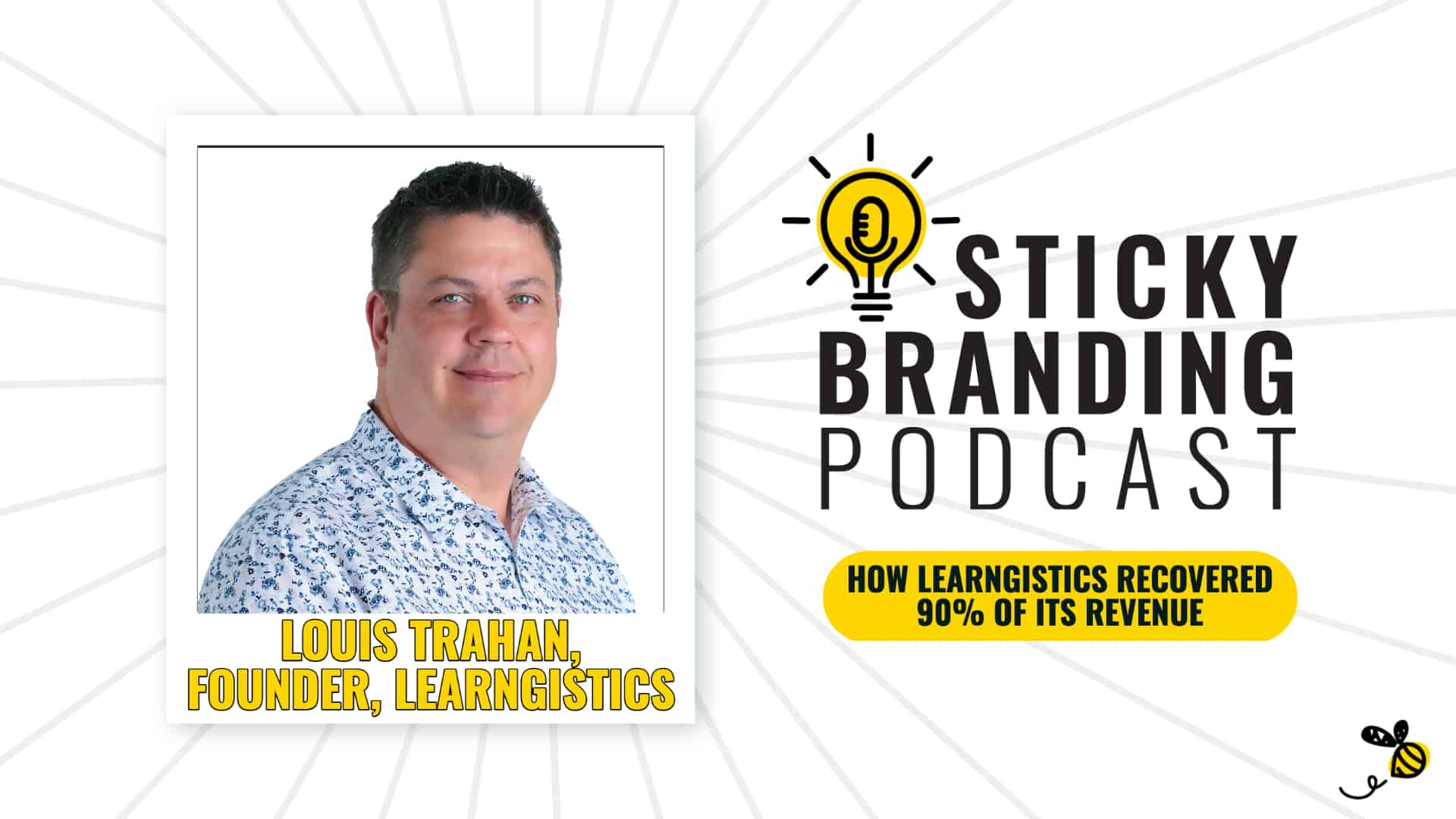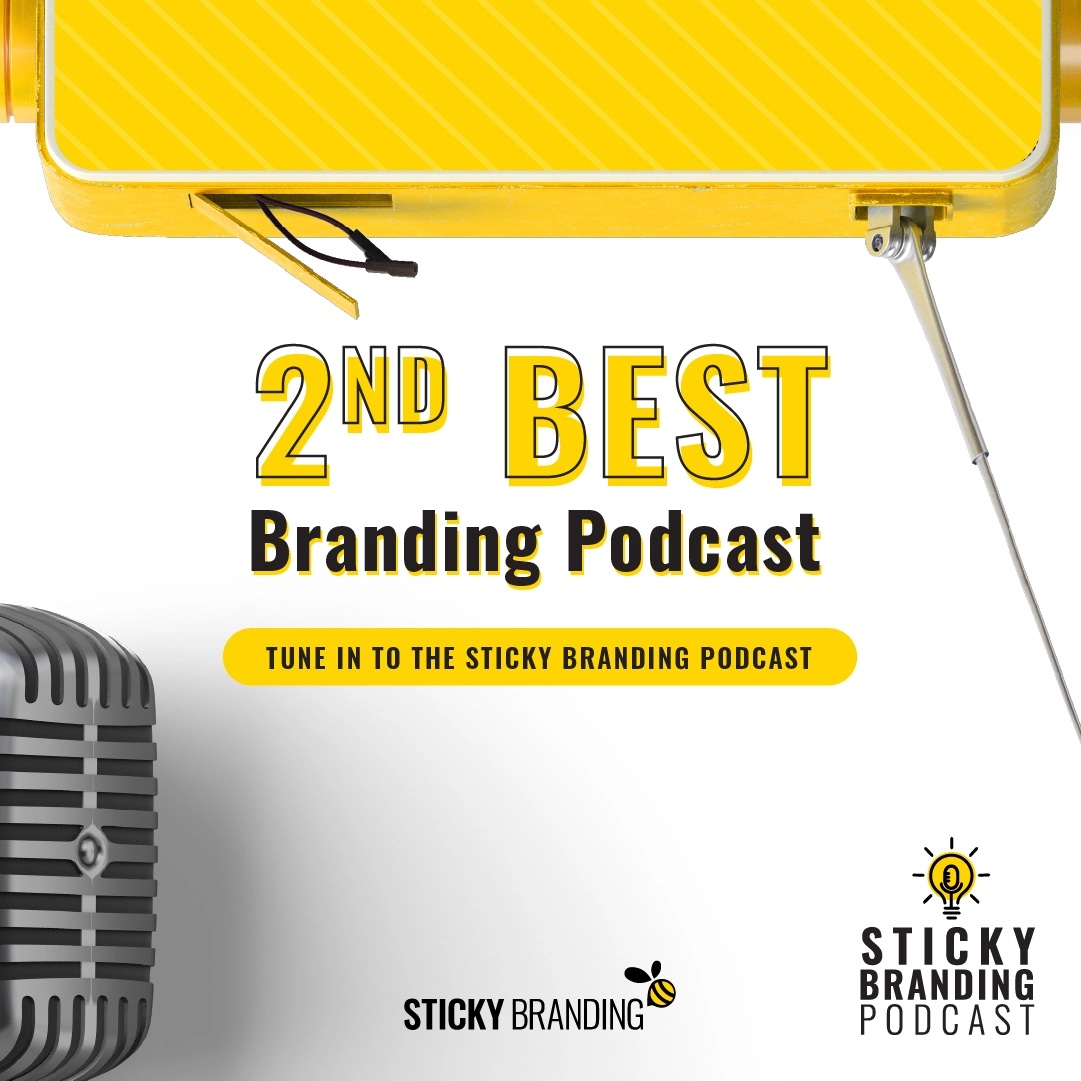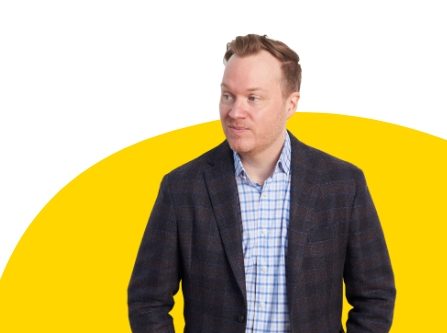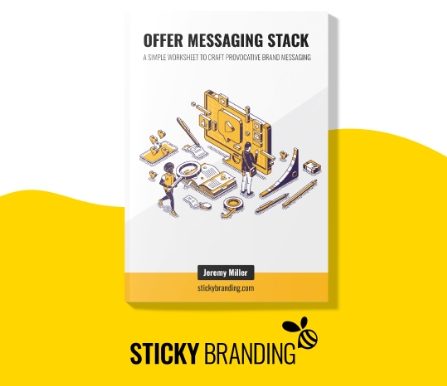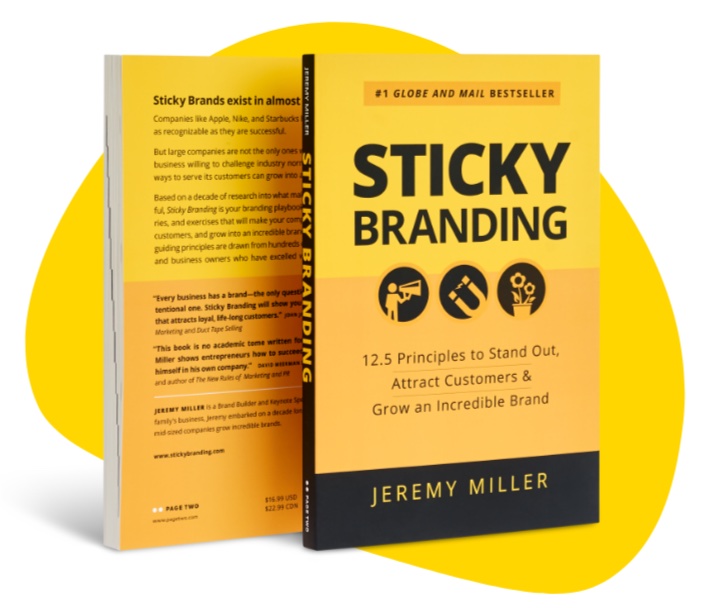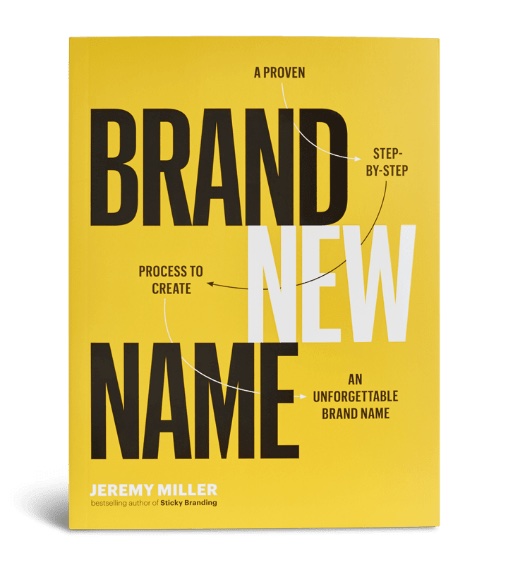– [Narrator] Brand X, brand Y, brand Z, not one sticks. Watch it again in slow motion.
– Welcome to the Sticky Branding podcast. In this show, we are unpacking how companies grow sticky brands. My name is Jeremy Miller, I am the founder of Sticky Branding and host of the show. Today I am very excited to introduce you to Louis Trahan. Louis is my friend, a client, and the CEO and founder of Learngistics. Louis, welcome to the show.
– Thanks for having me Jeremy, I appreciate the time.
– So, we start this show off, always with the same question, it’s always a way to test someone’s elevator pitch but tell me about Learngistics. Who are you guys and what do you do?
– Sure, Learngistics is a learning support company and we help corporations support the logistics of running their learning programs, whether that’s finding trainers, or booking training rooms, or producing training for them, whatever the logistics are, we handle that.
– Amazing. And you’ve been doing this for a long time. When were you founded?
– 2005. Bravely went out on my own.
– So, this is the part where it gets intriguing for me is that you operated for a very long time under Last Minute Training. And through the pandemic, and in 2020, you changed the company name and rebranded to Learngistics. And I know there’s a story here, so tell me about the pandemic. What did that do to your business?
– Well, it actually started a bit before the pandemic. When we started 17 years ago in 2005, Last Minute Training was a marketplace. It was a place you could find training at the last minute, save some money on public classes. But I think around 2019, the beginning 2019, we really sat down and looked at our revenue and realized that that marketplace was only accounting for about 25 or 30% of our revenue. Most of our revenue were coming from our corporate services and we had no brand to talk about our corporate services. We had nothing on our website about our corporate services, it was all just word of mouth and sales. And so we decided we were going to go on a quest to find a brand name to represent what we do as a company. And we started down the process and it kind of just petered along, you know, it was there, something to work on until the pandemic hit. Because when the pandemic hit all the things that we were used to doing stopped. So live training stopped, live events stopped, and we started to realize that if we were going to get through the pandemic we really needed to start talking about what we did as a whole and figure out how to do it during the pandemic.
– You go from a business that’s doing live events, live training, live experiences, March 2020 happens, we all know the experience now a year and a half, two years later with the pandemic, and basically the whole world comes crashing to an end. And knowing your story, you had a 90% fall in revenue. And just speak to that for a moment because it is such a jaw dropping experience that I can’t imagine many entrepreneurs ever want to experience.
– You don’t. And it was a bit scary, but we didn’t know how long it was going to last. So, as scary as it is in number, there was really no way to quantify or qualify it, it was just a number and it was, wow, we can’t do this for a long time, but hey, this is going to be gone in three months so maybe it will be okay. And if you think back to March, every day everything was changing. And so we, as a company, lost that 90% revenue within a week or two. And it was like every day someone was calling canceling something. And so every Monday I’d have a team meeting and our Mondays were pretty depressing. For three or four weeks, I mean, all we talked about was what we’re losing and how we were going to get through this. Are we going to have to shut things down? And it was not good for the team, it was not good for our mental health at all. So what we finally did was, I think it was a Sunday, I was sitting at home thinking about the fact that we can’t do anything about the pandemic. It’s happening, we don’t know when it’s going to end, we don’t know if it is a three month or if it’s a three-year or if it’s a forever issue. And there wasn’t anything we could do about it at that point, there were too many variables, there was too much missing information. What I did have was enough of a runway left that I didn’t have to, you know, have a knee jerk reaction and close down or fire people or reduce hours or anything like that. So instead what I said to the team when we met the following Monday morning was, Hey, we know we can’t really do anything about this so let’s do something that we can feel good about. And we talked it over and we knew there were a lot of trainers that were sitting at home, not doing training. We knew there were a lot of people losing their jobs. And we were thinking a lot of the service industry, like the restaurant industry, where, you know, your computer skills, your other job skills are maybe not at the point they should be to go out looking for alternate employment. And so we came up with this concept of creating a platform, which was our strength through Last Minute Training, and then asking the trainers if they wanted to advertise courses on it, and allowing people to sign up and pay whatever they want. And we called it, not so originally, paywhatyoucan.training. And that’s what got us through the pandemic. We set it up as a, 12 week program, we had an audacious goal of a hundred thousand learners in, you know, 12 weeks. Which, you know, I remember when we launched Last Minute Training, we were looking for a hundred learners in the first year. So a hundred thousand is a big number, probably wasn’t ever going to happen. It didn’t happen, but we didn’t care. The people who did participate, and there were a few thousand in 12 weeks, which was awesome, loved what we were doing, the trainers loved what they were doing. And it really opened our eyes to where we could help in a virtual world when it comes to corporate learning. And we were missing that up to that point.
– That’s remarkable. I love the entrepreneurial spirit is that you lose one side of your business and you start to think and explore, where else can you go? And you use those core skills and assets that you had to create the Pay What You Can platform. And we’ll come to this bridge, I’ll short circuit a little bit, which is a year and a half later you’ve largely reinvented your business and are pioneering services that didn’t exist, or they weren’t really true categories, before the pandemic. And one of the key areas of growth for Learngistics has been Virtual Classroom Producers. Can you give us an explanation of what that is? And then where did it come from? Cause there’s a clear tie to what you did with Pay What You Can, and how that leveled you through this story.
– No, absolutely. And they are tied in together. What we realized while we were offering these opportunities to trainers to offer training on this platform is that so many of them just didn’t know how to use the technology. And it wasn’t, I don’t know how to use the technology, I don’t know how to push a button. It was that the skill set required to be a presenter, to train, is not necessarily the same skill set you’re using to manage a platform. And anytime that we would see a trainer move from presenting to pushing buttons, the impact of their messaging would change.
– So, can I stop you for a second on this? What do you mean by platform? Is that Zoom or Teams, or is it the broader side of online learning?
– I think it’s Zoom or Teams or Meet or Google Hangouts. What happens is you have a trainer teaching, training, and you gotta understand that these trainers had to do a lot of work to move from live to virtual because you can’t deliver your live classes virtually in the same manner, in the same time frames with the same exercises. So you have to modify how you deliver it. So they were modifying, not only how they delivered it, which was taking a mindset, but now they had to think about how to share a screen, how to look at a chat, how to set up breakout rooms. And so what would happen is you’d have someone going on and on and doing well, and then he’d be like, okay, well, let’s get to the next topic. And here, let me share the screen with you. How do you do that again? And just the flow was gone. So as a trainer, it was stressful, but as a learner or as a participant, it was horrible. I mean, it was bad enough we were all trying to figure out Zoom fatigue and all these other issues, but now you have presenters who are delivering and you’re sitting there waiting, waiting, decide to check your mail, basically check out. And we started offering the service of working as a co-pilot, a co-host, a co-facilitator, whatever you want to call it, for free to those trainers, just to help them. And through doing that we realized that this was a real need. That there were real corporations running real training programs that were suffering because their trainers had all this additional weight put on them. Because all the onus went to the trainers and some of them were using other trainers to help, some were using executive assistants. And so we decided that this is a service we wanted to get into and we started launching it. And it really was a big part of how we were able to pivot out of COVID and it has become a really large part of our business. I would say right now, the largest segment of our business.
– It’s remarkable. I’ll reinforce just what you’re describing, because cause I can relate this. Through the pandemic I had to transition my business from doing live speaking, live events, keynotes, which was a significant part of the work we do at Sticky Branding, to virtual conferences, virtual keynotes. And I can tell you firsthand how hard it is to monitor the chat, do Q&A, or facilitate a breakout, and speak at the same time. It’s like walking and chewing gum, but way worse. And you’re absolutely right on the flow of things because it’s like live broadcast television. You’re supposed to be staring at a screen to create a connection, and now you’re looking at the bottom of your monitor, trying to see what’s going on in the chat while clicking over here to advance your slides and you feel like an octopus. So having this extra person there to just do, to be your producer so that you can do what you’re there to do is a godsend.
– No, it’s absolutely the case. And Jeremy you’ll know this, but I’m assuming that when you were live, if the microphone died halfway through your presentation, you didn’t walk over to the mixing board and try to fix it.
– Never.
– You probably just waved to the AV guy who ran out with a new mic, gave it to you, and then they ran back off stage and you continued on. The onus wasn’t on you as a live speaker to deliver the technology, so why is it on you as a virtual speaker?
– That’s a great point. And as a virtual speaker, I have no feedback. I have no idea that my slides are pixelated, my audio is poor, I’m missing chats, I’m doing whatever. The feedback loop is really difficult when you’ve got your lights, your camera, your microphone. And so I’m fully with you on just the need here. But, from the customer perspective I would imagine, I guess it’s a two part question. The first one would be, we have gotten better with the technology I would hope. So we understand Teams and Zoom, it’s not new, we’ve spent a year on it. Do companies still need those Virtual Producers? I think we’ve already answered that question, but I’m assuming that there might be some resistance, at least from an executive perspective going, what do you mean you need a producer? You can push those buttons.
– So, Jeremy, you’re right. There are some companies who would say that. But what we’re finding is, the ones who really care about the learner experience, who really care about the trainers that they have on the team, are not saying that, they are using people. The biggest challenge we’re finding actually is, or the biggest not challenge, but the biggest opportunity we’re getting is that these same companies who have been using support, have been using internal people. And those internal people have other jobs and they’re getting busy, and what these companies are realizing is they need to look for dedicated producers to help. The reality is, you can do it yourself. I mean, you know how to share a screen, right?
– Of course.
– Right. But how does your flow work? How does your message work when you’re excited, you’re moving, you’re moving, and all of a sudden, you’re going down here to start a breakout room. And all that credibility you build as a speaker by presenting yourself properly, the way you speak, the messaging you put together, starts to go away when all of a sudden you’re dawdling around with technology and fumbling your way through.
– Does the customer know that this service exists.
– From a Sticky Branding podcast marketing point of view, that’s a fantastic question because honestly, the service is such a unique service. It’s not that it wasn’t there before, there have been Virtual Producers before. WebEx has been around doing virtual learning forever and they’ve talked about using Virtual Producers, but really no one would have heard of it. So now the role is known, but what to call it is not known. So you have some people calling it co-pilots, co-facilitators, a Sherpa, I mean, you can call it almost anything. As a matter of fact, I had a great conversation with a potential client just recently. And I said, after listening to what they want to do, I said, well, great, our producers can do this, this, this, and this. And they said, oh, but we don’t need a producer. We need a host to do this, this, this, and this. But the thing is those two, this’s, they were all the same. But the word producer was confusing to the client. So as a company, I think our biggest challenge right now is trying to figure out how to get people to standardize on a term. Is it a Virtual Classroom Producer? Is it a Virtual Producer? Is it a co-facilitator? Is it a co-host? Is it a co-pilot? Is it a Sherpa? Is it a technical? Like we just don’t know. So Learngistics has decided we are going to call them Virtual Classroom Producers, and that’s what we are hoping to enable across the industry is the standardization on one type of name.
– It’s not a hope, we’re going to make it happen. Because we’re working together to get Virtual Classroom Produces known by everybody. And I do believe what we’re doing right now is creating a category that didn’t exist before the pandemic. And this is an example of a blue ocean strategy, or creating a market that didn’t exist. And I always think back to Whole Foods. Now, Whole Foods always built their brand based on raising the profile and category of natural and organic foods. And as that industry and that category rise, they rose as the pinnacle, as the key brand on it. Tesla’s doing the same thing with electric vehicles. Learngistics is doing that now with Virtual Classroom Producers. Now, you’re at the starting line obviously, but this is the exciting opportunity that you are defining this, there is a clear need, and there’s this moment to educate customers on that. And I think that’s partially why we’re having this chat today. But if I pull this back down to the practicality of things, the other key question I’ve got is, we’re going back to an in-person world, do you think the role of online learning will be diminished or decline in a post pandemic world? Or have we been exposed to something that’s now here to stay?
– And that’s a great question. Obviously, something that we think about every day, but I truly believe we’re, at least in the L and D world, I won’t speak for presentations and conferences, but from a corporate L and D space, we’re really at a crossroads here. We have an opportunity. There was always remote learning available for many years now, but everyone was resistant to it. Is it going to work? Was it going to work? Well, COVID forced us to make it work. And so what’s happening is, you know, we were here at live events, now we’re here with virtual events. The question is, what’s going to be over here? And we don’t have to go back and start where we were, we can start from where we were. So I believe that everything, not everything, but most corporate learning will either stay virtual or become hybrid. And by hybrid what I really mean is, there will be groups of live students connected to remote students. And I think we’re in a position right now while we’re here to really make that transition over. But what it’s going to really take is rethinking when I say rethinking what I mean is, traditionally people would say, well, we’re going to run a hybrid event. So we’re getting this live event. How can we bring in remote? What I believe has to happen is, we need to plan the learning for the remote students and figure out how to bring the hybrid in. Think about it as a mobile first approach to learning. When you’re planning a website now you plan for mobile, not for desktop. So I think we need to go to a remote first way of planning, learning, corporately, and then deal with the live. And I think if we do that, we’re going to see some big benefits. The learnings easier to apply cause you can break it up into chunks, you lose all the legacy costs that normally go around with live learning. And for us as a company, you still need that producer, there’s still that bridge between the live and the remote. So at that point, maybe it’ll change. Maybe some of the role will be remote participant advocate or, you know, technical monitor, we don’t know what the wording will look like, but the need to have a technical producer to help bridge those will increase, it won’t decrease. Because now you have physical technology as well as the virtual technology to deal with.
– I think what’s so intriguing right now is that the pandemic caused a disruption. Now we knew, and L and D had been thinking about these ideas for a very long time, but what the pandemic and COVID did was, it was this catalyst that forced the change upon us in a very rapid way. We didn’t change for it, these ideas were here, we’re just now executing what we always knew. And it creates this permission to innovate. And it’s this golden moment in time that like, just like you’re doing right now, creating a Virtual Classroom Producer and being a part of the disruption is reshaping what learning and training will look like in the next decade. And that’s got to be a fascinating and fun place to be with your business.
– Yeah, it is. And it will be really interesting to see, when we look back in 20 years, how pivotable this moment really was, and hopefully we’ve made the right decisions as an industry.
– Well, I think, obviously everything gets shaped in the moments and that’s what it means to be an entrepreneur and a business owner. Now, I want to just take a one more pivot here, and this is, we’ve been alluding to this throughout our conversation and some of the work we’ve done together, but I’d love if you could share with the listeners, what’s it been like working with me and Sticky Branding.
– It’s been horrible. I am kidding. I’m kidding. It’s been awesome. Obviously we still work together so I have a lot of respect for what Sticky Branding does. For me, as an entrepreneur though, I think the key benefit that I derived from this was having someone else to speak to who had a system in place to test theory. Because that becomes the challenge when you’re faced with something like COVID happening is that, you know you have to pivot, but you don’t know if the pivot’s right. And so you need to come up with what that service is gonna be, and you need to test it. And this is not the good old days. You don’t have a year to test it, you have a few weeks. You have limited resources, you’re moving fast, so you need to find that idea, test it, if it works, go all in, if it doesn’t work, shelve it really fast. And that in the beginning of the pandemic was so important to us, and I think, important to many people that you work with. The second thing that we got out of this of course, was, as I mentioned in the beginning, we had started thinking about rebranding and we were muddling along. And so having some clarity around the branding and how to tell a brand story, how to rethink our services and repackage our services was, we would still not be rebranded if we hadn’t engaged Sticky Branding. I just can’t see how we would have made it happen. So that was a huge benefit to us. And we keep working with you because we keep seeing those same benefits over and over again.
– That’s amazing. That’s such an honor, thank you. So I think the question would be, for everybody now is, how do we see this brand? How do we see Learngistics? What’s the best place to find Learngistics and you?
– So, the best place to find Learngistics is online in our easy to spell URL, learngistics.com. The second place is on LinkedIn. You can find me search for a Louis Trahan Toronto, I’m pretty sure I’m one of the only ones who pop up and should be able to find me there. That’s the two best ways.
– Amazing, and we’ll put the links into the show notes. Louis, thank you for today’s conversation, it has been fantastic.
– And thanks for having me, I really appreciate the chance to talk about this stuff.
– And thanks for everybody for tuning in to another episode of the Sticky Branding Podcast. Be sure to subscribe wherever you get your favorite podcast. All of these episodes are up on YouTube. Like it, share it, subscribe to the channel, and visit us at stickybranding.com for more ideas, best practices, and services on how to grow your business into a sticky brand.
